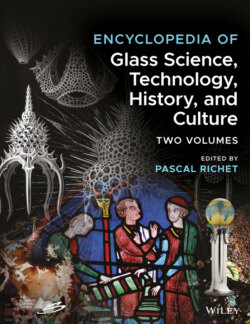Читать книгу Encyclopedia of Glass Science, Technology, History, and Culture - Группа авторов - Страница 329
5 Calculations of NMR Spectra
ОглавлениеA serious problem faced by NMR experiments on disordered structures is that the observed peaks may overlap so that real‐space interpretations of the spectra are not always straightforward. Theoretical calculations can thus give helpful guidance, but their difficulty is illustrated by the fact that the first NMR schemes have been proposed only 15 years ago. In the glass community, the so‐called GIPAW approach proposed by Pickard and Mauri [27] is certainly the most used one, and implemented in many ab initio packages. However, the theory on how this is done is rather involved, see Ref. [28], and therefore we just illustrate the kind of results obtained with calculations of 29Si Magic Angle Spinning spectra done for binary alkali and alkaline earth silicates (Figure 6).
Regarding the peak positions, the agreement between the ab initio simulations and the experimental spectra is remarkably good (Figure 6a). For lithium silicates, slight discrepancies are found for the peak intensities but they are likely due to the modest size and high quenching rates of the simulated samples. In fact, one can handle this problem by determining how the concentrations of the various structural units depend on the cooling rate (or on the temperature of the liquid) and then adjusting them to the actual experimental conditions [6].
Figure 6 Application of ab initio simulations to NMR spectroscopy [29]. (a) [29]Si magic angle spinning spectra of calcium metasilicate (CS), lithium tetrasilicate (LS4), and sodium tetrasilicate (NS4) glasses. (b) Dependence of the [29]Si isotropic chemical shifts on the Si–O–T angle calculated for different Q (n) species in 43 Na2O–57 SiO2 (NS1), 22.5 Na2O–77.5 SiO2 (NS3), NS4, and LS4 glasses. Solid lines: linear fits to the data.
Although NMR experiments provide information on the nature of the local structure (Q [n]‐species, connectivity of the atoms, etc.) it is difficult to extract direct information on the geometry of the local structures, such as bond angles. That ab initio simulations are also useful for this is demonstrated in Figure 6b where we show the chemical shift as a function of Si–O–T angle, where O is a first nearest neighbor of Si atom and T is the second Si atom bonded to that O. The data clearly show: (i) that there is a linear relationship between this angle and the chemical shift, (ii) that this relationship is basically independent of the composition of the glass, and (iii) that its slope depends on the Q (n)‐species of the second Si atom.
